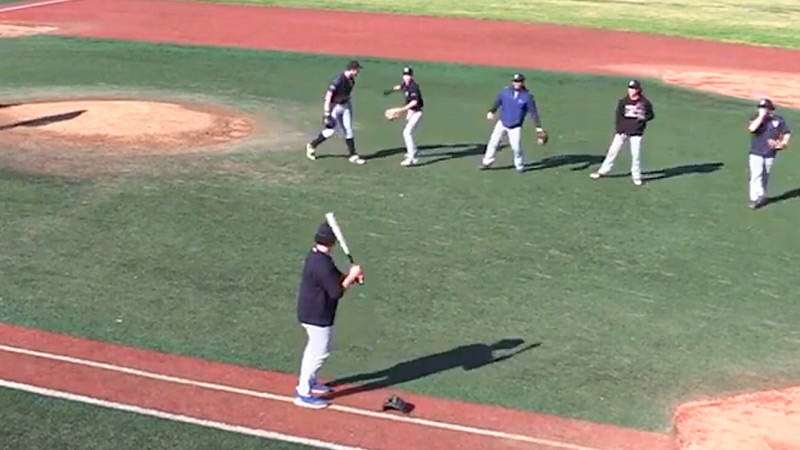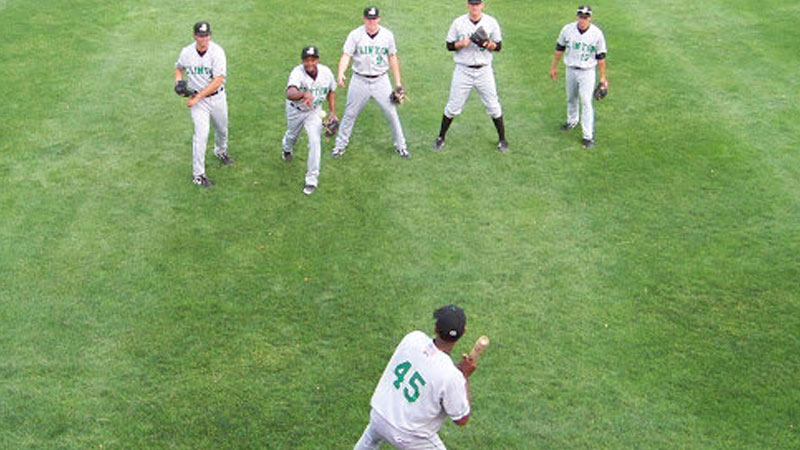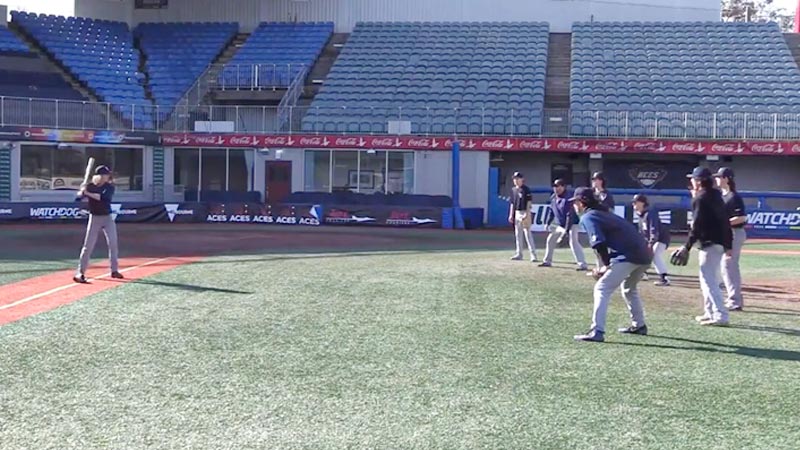Baseball, known as America’s pastime, has a rich history filled with various traditions and unique games. One such game is the “pepper game,” which has captivated players and fans alike for generations.
In this comprehensive guide, we will delve into the intricacies of the pepper game in baseball, exploring its origins, rules, benefits, and even the reasons behind its banishment from certain ballparks.
By the end, you will have a thorough understanding of this beloved baseball activity. Stay focused.
What Is A Pepper Game In Baseball
A pepper game is an informal and often impromptu practice activity in baseball. It involves a small group of players engaging in a rapid-fire exchange of ground balls, line drives, and quick throws.
The objective of a pepper game is to improve players’ hand-eye coordination, reflexes, and overall fielding skills.
It is typically played in close proximity, with players standing close to one another and taking turns hitting and fielding the ball.
How to Play Pepper Game?
Playing a pepper game in baseball is a simple yet engaging activity that requires minimal equipment and space.
It serves as an excellent warm-up exercise or practice drill for players of all ages and skill levels. Below is a detailed guide on how to play the pepper game:
Step 1: Gather a Small Group of Players
To initiate a pepper game, gather a small group of players, ideally between three to six individuals. This number ensures active participation and allows for smooth ball movement during the game.
The players can be from the same team or mixed teams, depending on the purpose and context of the game.
Step 2: Acquire a Baseball
The primary equipment needed for a pepper game is a baseball. Ensure that the baseball is in good condition, with adequate stitching and appropriate hardness to facilitate clean hits and accurate fielding.
Step 3:Form a Line or Semi-Circle
The players should arrange themselves in a line or form a semi-circle. This formation allows for easy ball exchange and efficient communication among the players. The hitter takes a position slightly apart from the rest of the group to have a clear view of the players and provide a suitable hitting angle.
Step 4: Designate a Hitter
In a pepper game, one player is designated as the hitter. The role of the hitter is to lightly hit the ball towards the other players, generating ground balls and line drives for them to the field.
The hitter should have good control over their hits to ensure the safety and enjoyment of the game.
Step 5: Fielding and Ball Return
As the hitter makes contact with the ball, the other players must react quickly to field it cleanly. The objective is to field the ball and return it to the hitter in a swift and controlled manner.
Players can use their gloves to catch the ball or field it barehanded, depending on personal preference and skill level.
Step 6: Rotating Roles
The cycle of hitting and fielding continues as each player takes turns being the hitter. This rotation ensures that every participant has the opportunity to practice both hitting and fielding skills. It also allows players to experience different positions within the game.
Pepper Rules in Baseball

Although the pepper game is relatively informal, there are a few unwritten rules that players typically follow to maintain the flow and safety of the game.
While these rules may vary slightly depending on the group or context, the following guidelines are commonly observed during a pepper game:
Quick and Controlled Ground Balls and Line Drives
Players should aim to generate quick ground balls and line drives when hitting the ball. This helps maintain the tempo and intensity of the game while providing fielding opportunities for the other players.
Hitters should avoid hitting pop flies or hard shots that could endanger the safety of the participants.
Accurate Throws
Players should make accurate throws back to the hitter after fielding the ball. This ensures the smooth and uninterrupted flow of the game. The goal is to return the ball promptly and with accuracy to the hitter, allowing them to continue hitting without unnecessary delays.
Communication and Coordination
Effective communication and coordination among players are essential during a pepper game. Players should call out their intentions, such as calling “mine” when fielding a ball to avoid collisions or confusion.
Clear communication helps create a cohesive and efficient playing environment.
Adaptability and Flexibility
The pepper game encourages adaptability and flexibility in players. As the ball comes off the hitter’s bat, players must adjust their positioning and movement to field the ball effectively. This adaptability helps improve reaction times and enhances overall fielding skills.
Safety First
While the pepper game is an enjoyable activity, safety should always be a top priority. Players should be mindful of their surroundings, maintaining a safe distance from other participants and any potential hazards.
Hitters should avoid hitting the ball too hard or in a manner that puts others at risk of injury.
By following these unwritten rules, players can create a fun and challenging pepper game experience while ensuring a safe and enjoyable playing environment.
The game allows individuals to develop their fielding skills, hand-eye coordination, and teamwork, making it a valuable addition to baseball practice sessions or warm-ups.
The Advantages of Playing Pepper Game

Source: hempfieldbaseball.com
Check out the following advantages of playing a pepper game.
Enhancing Hand-Eye Coordination, Reflexes, and Fielding Skills
Pepper games provide an exceptional opportunity for players to improve their hand-eye coordination, reflexes, and overall fielding skills. The fast-paced and close-quarters nature of the game demands quick reactions, forcing players to sharpen their reflexes.
As the ball is hit rapidly and unpredictably, players must focus intensely, track the ball’s trajectory, and make split-second decisions on how to field it.
This constant practice of tracking and reacting to the ball significantly enhances a player’s ability to field ground balls and line drives effectively.
Anticipating Movements and Developing Cohesion
Pepper games foster effective communication and teamwork among players. As they work together to field and return the ball, players develop a heightened sense of anticipation for their teammates’ movements.
The close proximity in which the game is played encourages constant verbal and non-verbal communication, allowing players to coordinate their actions and react efficiently.
To successfully navigate the fast-paced exchange of the ball, players must develop a cohesive fielding unit.
They learn to anticipate where their teammates will be positioned and adjust their movements accordingly. This collaborative aspect of pepper games nurtures a sense of trust and unity among players, strengthening their teamwork skills.
Rhythm, Muscle Loosening, and Focus Enhancement
Pepper games serve as an ideal warm-up activity before games or practices. They help players get into the rhythm of the game, allowing them to familiarize themselves with the movements and actions required in a live game scenario.
The rapid succession of hits and fielding repetitions helps players mentally and physically prepare for the upcoming game or practice session.
Furthermore, pepper games facilitate the loosening of muscles and joints, reducing the risk of injuries during subsequent activities.
The dynamic nature of the game requires players to move quickly and engage multiple muscle groups, effectively warming up their bodies.
Beyond physical preparation, pepper games also enhance players’ mental focus. The constant flow of hits and fielding demands concentration and mental agility.
By engaging in the game, players sharpen their ability to focus amidst distractions, a valuable skill when performing in high-pressure game situations.
Maximum Practice in Minimal Time
One of the significant advantages of pepper games is their time efficiency. With minimal equipment requirements and a compact playing area, pepper games can be played anywhere and at any time.
Whether it’s in a small backyard, a practice field, or even indoors, players can engage in pepper games without extensive setup or preparation.
Due to their simplicity and fast-paced nature, pepper games allow players to maximize their practice time even in limited timeframes.
A short 5 to 15-minute session can provide players with a significant number of repetitions and opportunities to refine their fielding skills, making it an excellent choice for time-constrained practices or pre-game warm-ups.
Moreover, the flexibility of pepper games allows players to incorporate them into their regular training routines without disrupting the overall schedule.
Players can easily integrate pepper games as a supplementary drill alongside other practice activities, ensuring a comprehensive and efficient training session.
Why is Pepper Game Banned at Some Ballparks?
Despite the numerous benefits associated with pepper games, they have been banned at certain ballparks for various reasons.
One primary concern is the risk of injuries, especially in crowded stadiums where spectators may be in close proximity to the field.
Additionally, the speed and intensity of a pepper game may pose a danger to players if they are not adequately trained or if there are uneven playing surfaces.
In order to prioritize safety and mitigate liability risks, some ballparks have opted to prohibit pepper games.
FAQs
Can pepper games be played with a softball instead of a baseball?
Absolutely! Pepper games can be played with softball instead of baseball without any significant changes to the rules and objectives. The primary difference lies in the size and weight of the ball, as softballs are larger and slightly heavier than baseballs.
However, this variation can add an exciting twist to the game, requiring players to adjust their fielding techniques accordingly. The essence of the pepper game, which focuses on improving hand-eye coordination, reflexes, and fielding skills, remains unchanged regardless of the type of ball used.
Is there a minimum or maximum number of players required for a pepper game?
Unlike formal baseball games, pepper games do not have strict requirements regarding the number of players involved. Ideally, a small group of three to six players is considered optimal for a pepper game.
With this number, players can rotate between hitting and fielding roles efficiently, maintaining a fast-paced and engaging session. However, it’s worth noting that pepper games can also be adapted for larger groups if desired.
In such cases, players can form multiple lines or semi-circles, allowing for more participants to engage in the game simultaneously.
Can pepper games be played indoors?
Yes, pepper games can be adapted to be played indoors, particularly in gymnasiums or other suitable spaces with enough room for fielding and hitting.
This adaptability makes pepper games a versatile option for practice sessions, regardless of weather conditions or limited access to outdoor facilities.
When playing indoors, it’s important to consider the playing surface to ensure safety and prevent damage. Utilizing softer balls, such as foam or indoor training balls, can also minimize the risk of accidents or property damage in indoor environments.
Are there age restrictions for playing pepper games?
Pepper games can be enjoyed by players of all ages and skill levels. The simplicity and versatility of the game make it accessible to both young beginners and seasoned veterans. However, it is advisable for younger players to be supervised by coaches, parents, or experienced players to ensure their safety during the game. Supervision can help prevent accidents and provide guidance on proper technique and etiquette.
How long should a pepper game session last?
Pepper games are typically played as warm-up activities, designed to get players in the right mindset and physical state before more structured practice or game sessions.
As such, a pepper game session usually lasts anywhere from 5 to 15 minutes. However, the duration can be adjusted based on the preferences and needs of the players and coaches.
Some teams may prefer shorter pepper game sessions to conserve energy for other drills, while others may extend the duration for additional skill development and conditioning.
Bottom Line
The pepper game in baseball is an enjoyable and valuable activity that fosters skill development, teamwork, and efficient warm-up sessions.
While its popularity remains strong, certain ballparks have banned the game due to safety concerns.
Nevertheless, pepper games continue to be cherished by players at all levels, serving as a testament to the enduring appeal of this informal yet impactful practice drill in the world of baseball. Best wishes.







